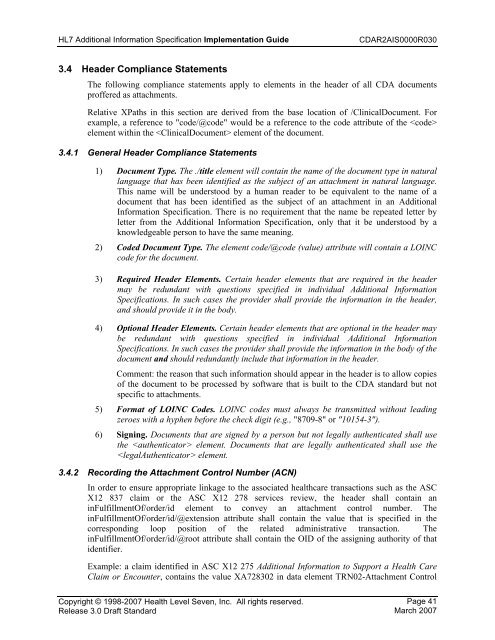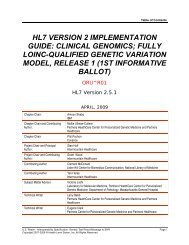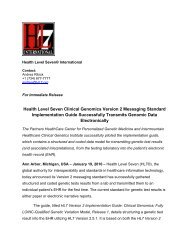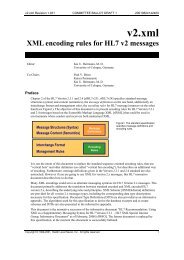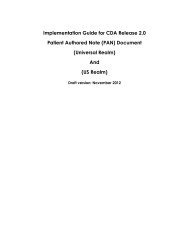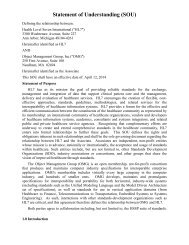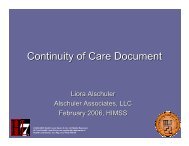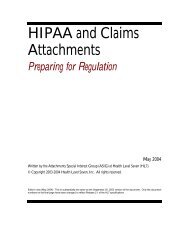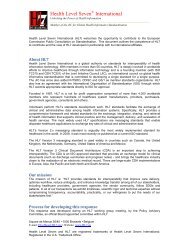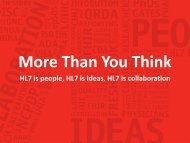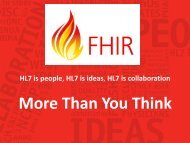HL7 CDA R2 AIS Implementation Guide
HL7 CDA R2 AIS Implementation Guide
HL7 CDA R2 AIS Implementation Guide
Create successful ePaper yourself
Turn your PDF publications into a flip-book with our unique Google optimized e-Paper software.
<strong>HL7</strong> Additional Information Specification <strong>Implementation</strong> <strong>Guide</strong><strong>CDA</strong><strong>R2</strong><strong>AIS</strong>0000R0303.4 Header Compliance StatementsThe following compliance statements apply to elements in the header of all <strong>CDA</strong> documentsproffered as attachments.Relative XPaths in this section are derived from the base location of /ClinicalDocument. Forexample, a reference to "code/@code" would be a reference to the code attribute of the element within the element of the document.3.4.1 General Header Compliance Statements1) Document Type. The ./title element will contain the name of the document type in naturallanguage that has been identified as the subject of an attachment in natural language.This name will be understood by a human reader to be equivalent to the name of adocument that has been identified as the subject of an attachment in an AdditionalInformation Specification. There is no requirement that the name be repeated letter byletter from the Additional Information Specification, only that it be understood by aknowledgeable person to have the same meaning.2) Coded Document Type. The element code/@code (value) attribute will contain a LOINCcode for the document.3) Required Header Elements. Certain header elements that are required in the headermay be redundant with questions specified in individual Additional InformationSpecifications. In such cases the provider shall provide the information in the header,and should provide it in the body.4) Optional Header Elements. Certain header elements that are optional in the header maybe redundant with questions specified in individual Additional InformationSpecifications. In such cases the provider shall provide the information in the body of thedocument and should redundantly include that information in the header.Comment: the reason that such information should appear in the header is to allow copiesof the document to be processed by software that is built to the <strong>CDA</strong> standard but notspecific to attachments.5) Format of LOINC Codes. LOINC codes must always be transmitted without leadingzeroes with a hyphen before the check digit (e.g., "8709-8" or "10154-3").6) Signing. Documents that are signed by a person but not legally authenticated shall usethe element. Documents that are legally authenticated shall use the element.3.4.2 Recording the Attachment Control Number (ACN)In order to ensure appropriate linkage to the associated healthcare transactions such as the ASCX12 837 claim or the ASC X12 278 services review, the header shall contain aninFulfillmentOf/order/id element to convey an attachment control number. TheinFulfillmentOf/order/id/@extension attribute shall contain the value that is specified in thecorresponding loop position of the related administrative transaction. TheinFulfillmentOf/order/id/@root attribute shall contain the OID of the assigning authority of thatidentifier.Example: a claim identified in ASC X12 275 Additional Information to Support a Health CareClaim or Encounter, contains the value XA728302 in data element TRN02-Attachment ControlCopyright © 1998-2007 Health Level Seven, Inc. All rights reserved.Release 3.0 Draft StandardPage 41March 2007


